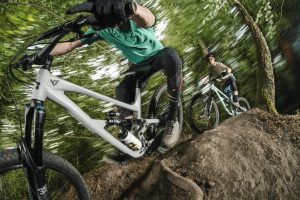How to bag a high-spec all-round full-suspension bike perfect for technical trails… for a reasonable price too
Best full-suspension mountain bike – Buyer’s guide
1. Shorter stem (40-70mm)
2. Wider bars, 700mm plus
3. 140-150mm travel rear suspension
4. 32 or 34mm stanchion diameter fork with 140-160mm travel
5. Thru-axle hubs front and rear
6. Fatter tyres (2.25-2.35in)
The focus here is on riding and having fun rather than efficiency or weight saving, and that means you don’t have to spend the earth to get a very good trail bike. There are some incredibly light and expensive trail bikes out there if you’ve got a huge budget, but for £2,500-£3,000 you can get an amazing bike. If you only have half of that then you might take a hit on the parts, but you’re likely to be riding the same frameset, which is a good foundation to build on.
Get this bike if…
You want an all-rounder. These are perfect bikes for riding technical trails with control and confidence, more stable and sure-footed than 120mm rivals and, despite the added weight, still capable climbers. If you want to push the limit on those trail centre descents, this is definitely the bike to have.
Key features
Dropper post
At around £250-300 a dropper post is an expensive bit of kit, which is why you don’t see many on trail bikes below £2,000, but it should be standard on anything above that. Some manufacturers also allow you to upgrade at point of sale and it’s worth taking advantage of these offers.
ISCG tabs
ISCG tabs should be standard attire for any 140mm trail bike. These special tabs on the frame allow you to mount a chain device with the minimum of fuss.
Thru-axles
Oversized thru axles add stiffness, improving tracking and steering response and also reducing binding in the suspension. Some sort of oversized thru axle front and rear should be standard on a 140mm trail bike, and they need to have a quick release function so you can get the wheel out easily.
Wide Handlebar
It’s a matter of personal preference, but right now wide bars are definitely in vogue with riders (if not always manufacturers). They offer more control, which is handy when you’re going fast down some rocky chute, but narrower bars are cheaper. Thing
is, if you start wide, you can always cut it down.
650b wheels
The new wheel size for 140-150mm trail bikes.
Short-travel full-suspension
1. Shorter (50-90mm) stems
2. Solid and lightweight aluminium bar. 29ers often fomer with flat or low-rise bars
3. 100-130mm rear wheel travel
4. 110-130mm travel suspension fork
5. Larger rotors (160-180mm)
6. Quick release thru-axle front and rear
7. Aggressive 2.1-2.35in tyres
8. Sturdy, tubeless-ready wheels
9. 29ers are popular with this amount of travel, but 650b will also be an option
Simply, this is a full suspension bike with around 120mm of travel designed for trail riding. If you cut it down the middle, the front half would look very similar to a trail hardtail and it may even have some of the same parts fitted. There’s no change in intended use, although you may be riding faster due to the extra grip and traction. The shock bumps up the price, so short-travel trail bikes can cost anything from £1,200 to £5,000.
Get this bike if…
You are looking for a lightweight, agile trail bike that covers ground quickly, but has enough about it to deal with the unexpected on technical trails. It will feel a lot more maneuverable compared to a traditional 140mm trail bike, and with 29er wheels it may even out perform it in certain situations.
Key features
Double or triple chainset
A triple chainset offers the widest range of gearing, but you might see 2×10 or even a 1x (one chainring, 10 sprockets) drivetrain on some short-travel trail bikes. Start with a triple if you’re new to the sport, as you can remove some of the rings at a later date.
Feature-rich rear shock
The more you spend, the more features you get. You’ll be able to customise your rebound and compression adjustment, as well as take advantage of predetermined settings designed for climbing, descending and trail use.
Adjustable Disc Brakes
Like rear shocks, the more expensive the bike the more likely the brakes will be adjustable. ‘Reach adjustment’ lets you alter the position of the levers (handy if you have small hands) and ‘contact point adjustment’ lets you change the bite point.
ISCG tabs
This is a three-point mount around the driveside bottom bracket onto which you can bolt a chain device. ISCG tabs (as they are known) are less common on shorter travel bikes but just as relevant.
Lightweight wheels
A short-travel trail bike should climb quickly, feel responsive and maneuverable and can be ridden all day without fatiguing the rider. Reducing the wheel weight is one way to achieve all those aims, and that’s why any bike worth a punt should have lightweight wheels built with double-wall aluminium rims and QR/thru axles at both ends.

















